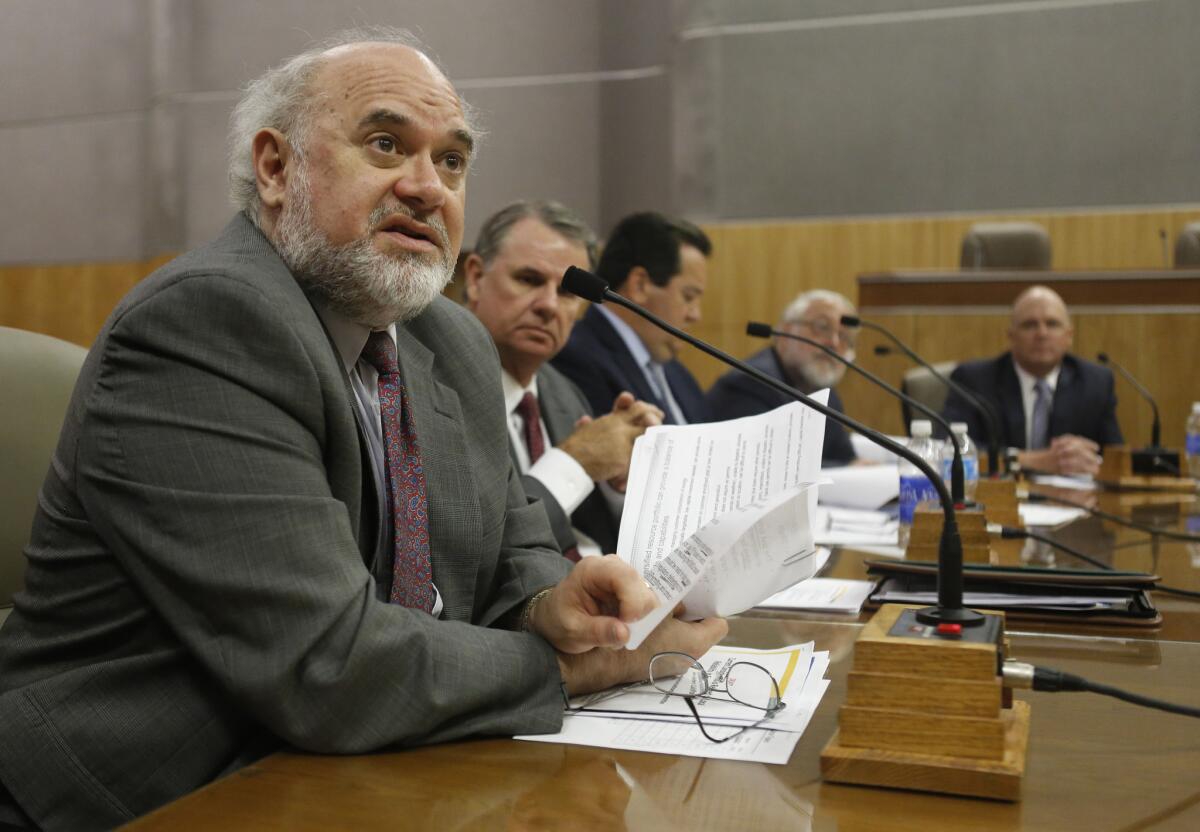California regulators approve higher electricity rates for most residents

Commissioner Mike Florio of the California Public Utilities Commission, left, talks during an informational hearing at the Capitol in Sacramento on July 10, 2013. California residents will see their electricity bills increase under a new rate structure passed Friday by state regulators.
- Share via
Electric bills are set to rise over the next few years for most household customers served by California’s major investor-owned utilities, including Southern California Edison.
The increases are a result of sweeping changes approved Friday by the California Public Utilities Commission — the first statewide rate overhaul since the 2000-01 energy crisis.
Modest and moderate consumers of electricity will bear a greater share of costs, while many larger users of electricity will see their bills shrink or increase less rapidly.
“There are real people behind these numbers, millions of people behind these numbers,” PUC Commissioner Carla Peterman said. “Some people will see their bills go down, but many more will see them go up.”
Major changes will show up starting next year on utility bills and be phased in over several years. Detailed information is not yet available.
The commission voted unanimously on a compromise between two competing proposals. Consumer groups raised objections to new provisions unveiled Wednesday after years of deliberations. They complained that it was inappropriate to hold the final vote on a federal holiday, even if state employees were scheduled to work Friday.
The commission adopted a plan for two price tiers for residential customers, with a 25% price increase as households use more power. Currently, prices more than double in many locations as heavy users use more electricity.
A higher premium will remain in place for a much smaller percentage of customers under a new “super-user electricity surcharge,” designed to penalize energy guzzling and encourage conservation.
Consumer protections imposed in the 2000-01 energy crisis effectively froze prices on a basic allotment of household power, thrusting utility revenue growth increasingly onto the bills of larger users.
The utilities found that modest and moderate electricity users pay much less than what it costs to serve them. That bill increase will be phased in slowly through 2020 to soften the effect.
Authorization also was given for a minimum bill charge of $10 a month, or $5 for subsidized customers, that gets paid even if electricity use drops to zero. It was unclear whether bill credits for rooftop solar energy can offset the minimum charge.
The Sierra Club opposed the revisions approved Friday, and warned that the changes would stifle conservation efforts.
“Customers using twice as much electricity as average can expect their bills to go down, while bills will be raised on everyone else,” the group explained.
The solar industry also opposed the bill changes.
Michael Powers, co-owner of San Diego-based solar provider Stellar Solar, said his industry could be headed for hard times if state regulators also embrace a new solar tariff that reduces incentives. Solar providers are bracing at the same time for the expiration of solar investment tax credit provisions at the end of 2016.
“Speaking as a business owner, I have to say it’s really hard to reconcile the state of California and the governor and the Legislature saying that we want clean energy to be an engine of economic development,” Powers said. “On the other side you have the utilities and the Public Utilities Commission making solar less and less affordable.”
The commission next plans to decide on a new system of tariffs and credits for rooftop solar to replace the current system. There, too, the solar industry and the utilities industry are at odds.
Utilities have long complained that the steeply tiered system means higher-use households have unfairly subsidized low-use households for years. They say that the gap has only increased, with low-use households not even paying for the cost of supplying electricity.
“It’s a matter of fairness,” said Russ Garwacki, director of pricing design and research at Southern California Edison.
Environmental and consumer advocates disagree, saying that the current tier structure promotes energy conservation. “This is really the utilities versus everybody else,” Evan Gillespie, a campaign director for Sierra Club California, said earlier in the week.
Morgan Lee writes for the San Diego Union Tribune.
The Associated Press was used in compiling this report.
More to Read
Inside the business of entertainment
The Wide Shot brings you news, analysis and insights on everything from streaming wars to production — and what it all means for the future.
You may occasionally receive promotional content from the Los Angeles Times.








